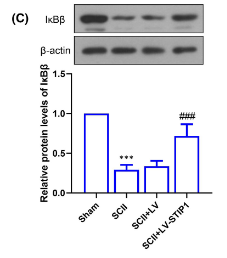IKB beta Antibody - #AF6448
| Product: | IKB beta Antibody |
| Catalog: | AF6448 |
| Description: | Rabbit polyclonal antibody to IKB beta |
| Application: | WB IF/ICC |
| Cited expt.: | WB |
| Reactivity: | Human, Mouse, Rat |
| Prediction: | Pig, Bovine, Horse, Sheep, Rabbit, Dog, Chicken |
| Mol.Wt.: | 37kDa; 38kD(Calculated). |
| Uniprot: | Q15653 |
| RRID: | AB_2835271 |
Product Info
*The optimal dilutions should be determined by the end user. For optimal experimental results, antibody reuse is not recommended.
*Tips:
WB: For western blot detection of denatured protein samples. IHC: For immunohistochemical detection of paraffin sections (IHC-p) or frozen sections (IHC-f) of tissue samples. IF/ICC: For immunofluorescence detection of cell samples. ELISA(peptide): For ELISA detection of antigenic peptide.
Cite Format: Affinity Biosciences Cat# AF6448, RRID:AB_2835271.
Fold/Unfold
I kappa B beta; I-kappa-B-beta; IkappaBbeta; IKB beta; IkB-B; IkB-beta; IKBB; IKBB_HUMAN; IkBbeta; NF kappa BIB; NF-kappa-B inhibitor beta; NF-kappa-BIB; Nfkbib; Thyroid receptor interacting protein 9; Thyroid receptor-interacting protein 9; TR interacting protein 9; TR-interacting protein 9; TRIP-9; TRIP9;
Immunogens
A synthesized peptide derived from human IKB beta, corresponding to a region within N-terminal amino acids.
- Q15653 IKBB_HUMAN:
- Protein BLAST With
- NCBI/
- ExPASy/
- Uniprot
MAGVACLGKAADADEWCDSGLGSLGPDAAAPGGPGLGAELGPGLSWAPLVFGYVTEDGDTALHLAVIHQHEPFLDFLLGFSAGTEYMDLQNDLGQTALHLAAILGETSTVEKLYAAGAGLCVAERRGHTALHLACRVGAHACARALLQPRPRRPREAPDTYLAQGPDRTPDTNHTPVALYPDSDLEKEEEESEEDWKLQLEAENYEGHTPLHVAVIHKDVEMVRLLRDAGADLDKPEPTCGRSPLHLAVEAQAADVLELLLRAGANPAARMYGGRTPLGSAMLRPNPILARLLRAHGAPEPEGEDEKSGPCSSSSDSDSGDEGDEYDDIVVHSSRSQTRLPPTPASKPLPDDPRPV
Predictions
Score>80(red) has high confidence and is suggested to be used for WB detection. *The prediction model is mainly based on the alignment of immunogen sequences, the results are for reference only, not as the basis of quality assurance.
High(score>80) Medium(80>score>50) Low(score<50) No confidence
Research Backgrounds
Inhibits NF-kappa-B by complexing with and trapping it in the cytoplasm. However, the unphosphorylated form resynthesized after cell stimulation is able to bind NF-kappa-B allowing its transport to the nucleus and protecting it to further NFKBIA-dependent inactivation. Association with inhibitor kappa B-interacting NKIRAS1 and NKIRAS2 prevent its phosphorylation rendering it more resistant to degradation, explaining its slower degradation.
Phosphorylated by RPS6KA1; followed by degradation. Interaction with NKIRAS1 and NKIRAS2 probably prevents phosphorylation.
Cytoplasm. Nucleus.
Expressed in all tissues examined.
Belongs to the NF-kappa-B inhibitor family.
Research Fields
· Human Diseases > Infectious diseases: Bacterial > Shigellosis.
· Human Diseases > Infectious diseases: Parasitic > Leishmaniasis.
· Human Diseases > Infectious diseases: Parasitic > Toxoplasmosis.
· Human Diseases > Infectious diseases: Viral > Measles.
· Human Diseases > Infectious diseases: Viral > Influenza A.
· Human Diseases > Infectious diseases: Viral > Herpes simplex infection.
· Human Diseases > Infectious diseases: Viral > Epstein-Barr virus infection.
· Organismal Systems > Immune system > Chemokine signaling pathway. (View pathway)
· Organismal Systems > Immune system > NOD-like receptor signaling pathway. (View pathway)
· Organismal Systems > Immune system > RIG-I-like receptor signaling pathway. (View pathway)
· Organismal Systems > Immune system > Cytosolic DNA-sensing pathway. (View pathway)
· Organismal Systems > Immune system > Th1 and Th2 cell differentiation. (View pathway)
· Organismal Systems > Immune system > Th17 cell differentiation. (View pathway)
· Organismal Systems > Immune system > T cell receptor signaling pathway. (View pathway)
· Organismal Systems > Immune system > B cell receptor signaling pathway. (View pathway)
· Organismal Systems > Nervous system > Neurotrophin signaling pathway. (View pathway)
· Organismal Systems > Endocrine system > Adipocytokine signaling pathway.
References
Application: WB Species: Rat Sample: spinal cord
Restrictive clause
Affinity Biosciences tests all products strictly. Citations are provided as a resource for additional applications that have not been validated by Affinity Biosciences. Please choose the appropriate format for each application and consult Materials and Methods sections for additional details about the use of any product in these publications.
For Research Use Only.
Not for use in diagnostic or therapeutic procedures. Not for resale. Not for distribution without written consent. Affinity Biosciences will not be held responsible for patent infringement or other violations that may occur with the use of our products. Affinity Biosciences, Affinity Biosciences Logo and all other trademarks are the property of Affinity Biosciences LTD.
